This reading unit of study focuses on reading mysteries in the classroom. Includes mini-lessons, anchor charts, graphic organizers & more.
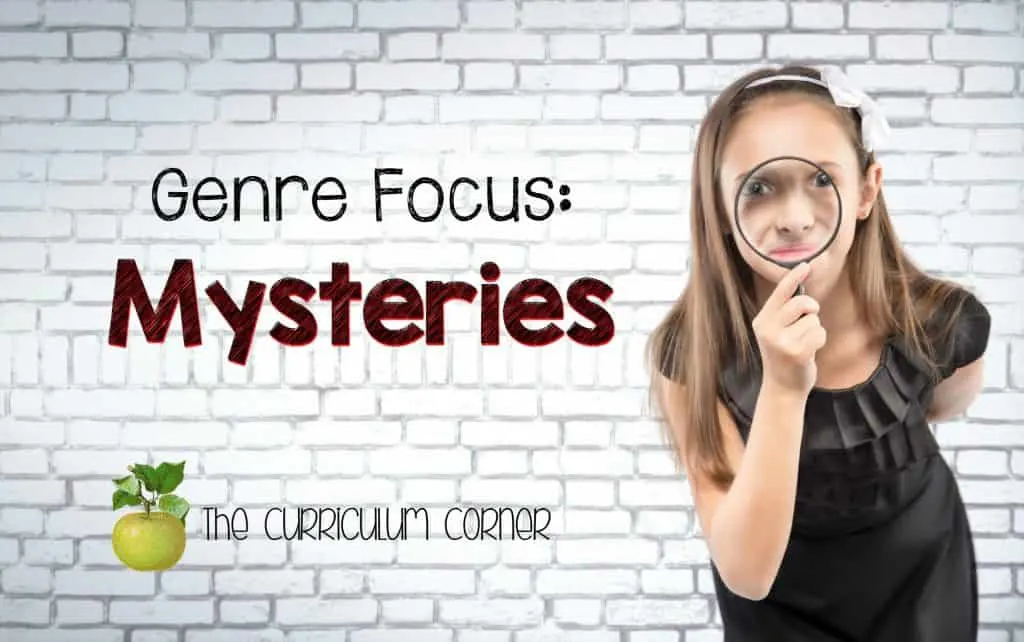
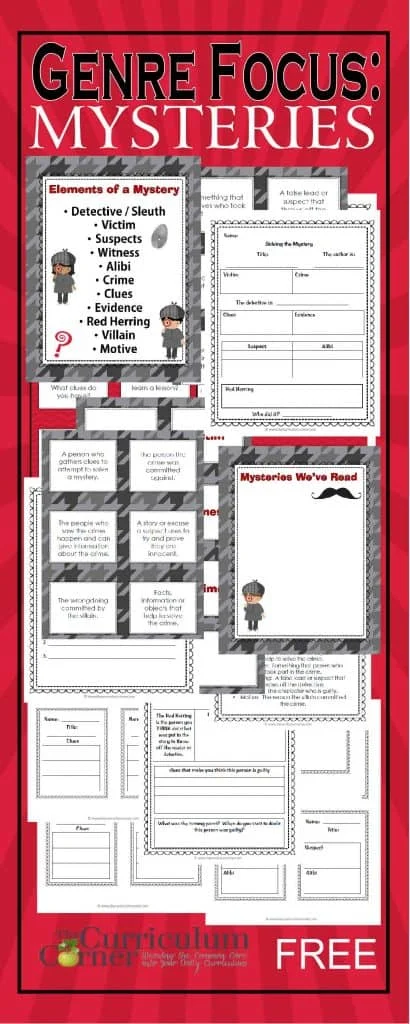 We believe that the best way to teach the genre of mystery in intermediate classrooms is to read aloud one or two shorter mystery novels and discuss the various story elements as they unfold in the novel. To that end, we have provided a few ideas for introductory lessons to give students some knowledge and background, but then we have also provided several graphic organizers that you would model where appropriate throughout your reading of the mystery novel(s) aloud to students. Our collection of resources also includes discussion ideas and exit tickets so that you can assess your students’ knowledge as you teach.
We believe that the best way to teach the genre of mystery in intermediate classrooms is to read aloud one or two shorter mystery novels and discuss the various story elements as they unfold in the novel. To that end, we have provided a few ideas for introductory lessons to give students some knowledge and background, but then we have also provided several graphic organizers that you would model where appropriate throughout your reading of the mystery novel(s) aloud to students. Our collection of resources also includes discussion ideas and exit tickets so that you can assess your students’ knowledge as you teach.
You can find the complete collection of reading mysteries resources described below by clicking on the bold, red link at the bottom of this page.
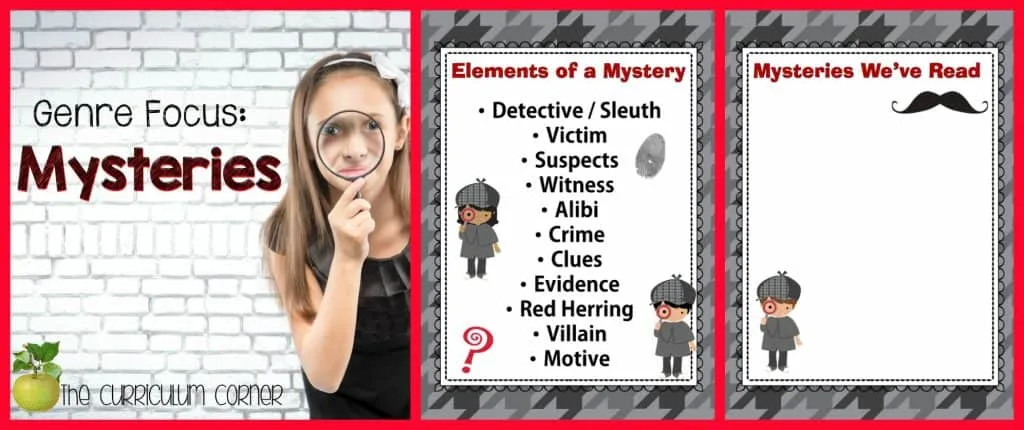
***Since some students may not be choosing to read mysteries during independent reading, think about gathering small sets of leveled mystery books for your guided reading groups during this unit. Or perhaps start book clubs, with the expectation that the groups will share the book in some way with the rest of the class when they are finished reading it. You can use the resources provided in so many ways. Once you’ve modeled the use of the graphic organizers, you can have students do them independently if you would like. Though mystery may not be the favorite of all your students, we want them to have some exposure to this genre so that gather knowledge about it, and if nothing else, perhaps at least gain an appreciation for it. After all…it takes a lot to write a “who done it” or solve a mystery!
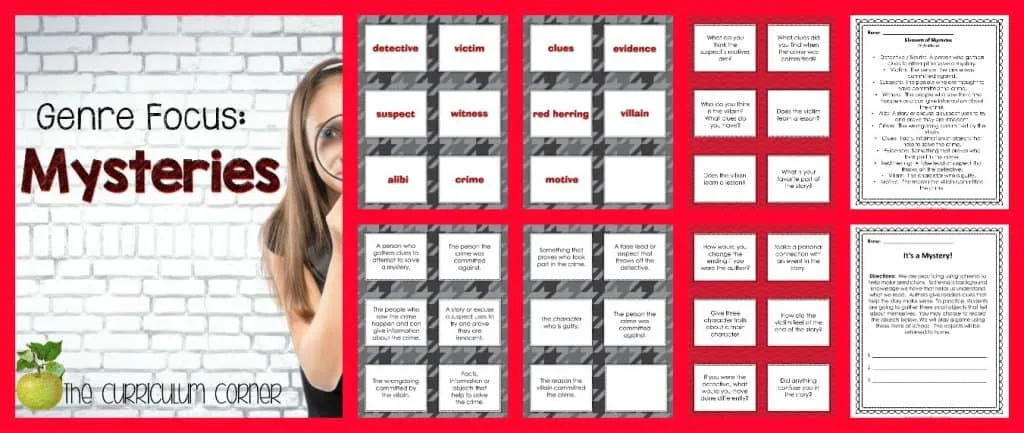
Emotional Hook: Staging a Crime Scene – One FUN way to get your students hooked the minute they enter your classroom is to set up a “crime scene” in your classroom. Make footprints leading from the hallway into your classroom and straight up to the scene. These might be the footprints of your principal or could even be the footprints of an animal such as a dog, a duck or a horse. Just think about who you want your villain to be and why he/she/it may have chosen to steal something from your classroom. Make it appear as if lamps or baskets have been knocked over, or things have been “rifled” through or tossed around. Remove something fairly prominent from your classroom – a picture from the wall, a favorite book that was on display or something else. The trick here is to give it some thought first and make sure that the villain had a motive for taking whatever is missing from your room. Maybe your principal “stole” a book to read to younger classrooms (He/she could come return the book later and apologize!) Perhaps you could make up a reason for an animal to steal the picture or other item for a specific reason. You might even want to cut out letters from a magazine and create your own ransom letter!!
Whatever scenario you come up with – think about providing the clues (footprints, item stolen, etc) so that students might be able to identify a possible suspect or two. Of course you can play this up as much or as little as you want to, but it’s sure to get the attention of your students. If you’re REALLY brave, you might want to think about enlisting the help of a colleague or staff member to be present in your classroom that morning and stage your own “kidnapping”. Of course the clues would lead the kids to determine that the motive for the kidnapping was that another student/class wanted the BEST TEACHER EVER!! 🙂 (On the second day they enter…maybe you could have some yellow crime scene tape draped across the top of your classroom door!!)
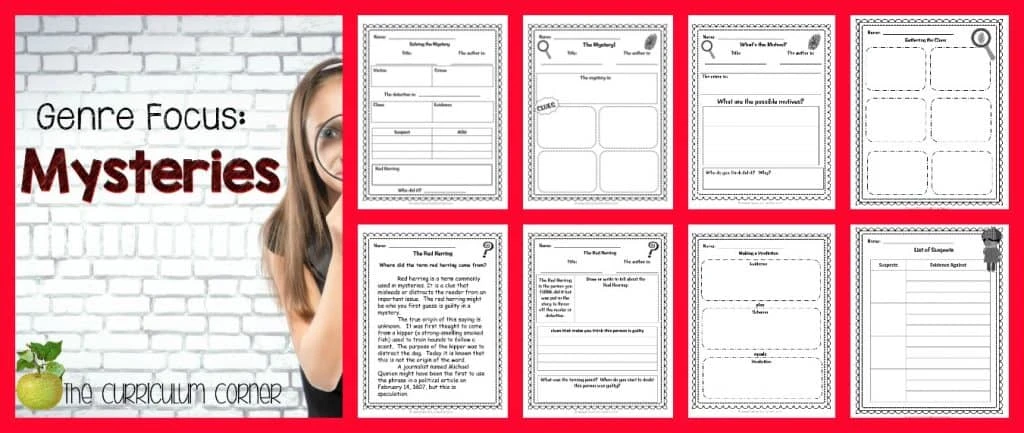
Introduction Lesson 1 – Elements of Mystery Novels – Prepare for this lesson by searching online for a short mystery video or cartoon for the students to watch. We happen to think a Scooby Doo episode would serve really well for this lesson!! Who remembers the Mystery Machine??! (You can also find Scooby Doo books to use. The elements of mystery are very apparent in these stories, which is why it is helpful to use them to teach mystery elements. We have provided some Amazon links below.) Also make copies of the definition page for each student to use in their reading binders, and make a poster of the graphic organizer “Solving the Mystery” (or prepare it for a Smartboard). Gather students and show them the video without much introduction. Once the video is over, ask students what genre they think the movie would fall into. After coming to the conclusion of “mystery”, brainstorm what aspects of the video caused them to come to the conclusion that it would be considered a mystery. Record their answers on a piece of chart paper. Next, display our anchor chart “Elements of a Mystery”. Many of the terms – detective/sleuth, victim, motive, suspects, witness, alibi, crime, clues, evidence, red herring, villain – might be similar to what they brainstormed. Pass out the definition page to students and discuss the meanings of each of these terms. Next, tell students to think of the video they watched and fill out the graphic organizer together. This will give them the modeling they need to complete this organizer later in the unit. To reinforce this lesson, we have also created word and definition cards that you might want to use as a center for reinforcement of the terms the students learned. They could simply match the words with the appropriate definitions or play a quick game of match.
Introductory Lesson 2: The Origin of the Term “Red Herring” – You may choose to simply have a brief discussion of the term “red herring” in mysteries and be done with it, but if you would like to go a little more in depth, you could do a short mini-lesson about the term. To prepare for this lesson, print off or gather some digital pictures of an actual herring fish…just to let many of your students know that a herring is, in fact, a fish. Also, print off several copies of our red herring passage. Remind students of the definition page and graphic organizer from the previous lesson. The definition of the term “red herring” was “a false lead or suspect that throws off the detective”. Reference the video clip you showed the class and discuss again if there was a red herring present in the mystery. Next, pass out copies of the passage to partners or small groups of students. Give them time to read and/or discuss the passage, and then pull them together to discuss the origin of the term and why it might be a good description of a distraction away from the truth in a mystery.
Introduction Lesson 3 : Using Schema to Help Make Predictions – To prepare for this lesson, take “mug shots” of five or six adults in your building. Print the pictures to display for your mini-lesson(or put all of them up on a Smartboard). Then choose one or two of those adults that students know well or would be able to identify using clues. Have those people place some items into an opaque bag that are to serve as clues as to who they are. (One fun idea is to use black or white gift bags and place large “?”s on the fronts.) For example – the librarian might add a book, a library card or other items found in their library. A cafeteria manager might add a piece of fruit, some silverware and a carton of milk. Maybe the principal has something specific that students always associate with him/her – a favorite book or accessory. Gather students and tell them that they are to try to guess who the the “Mystery Person” is by using the items that you will pull from the bag. One by one take out each item and discuss the “list of suspects” as possibilities. After all the items have been shown, reveal who the “Mystery Person” is. Ask students if their predictions were right or wrong. Discuss with students that they have used the clues provided PLUS their schema (previous knowledge or background) to figure out the Mystery Person. Use the graphic organizer “Evidence + Schema = Prediction” and go through the objects one at a time to talk about the students’ schema for each of the pieces of “evidence” you pulled out of the bag. Finally, let students know that using their schema in mysteries will help them to make predictions about story events, characters (suspects) and even the villain in the story.
Unit Celebration Idea – At the end of our reading or writing units, we have always loved the idea of celebrating the learning with something fun. Decorate your room a bit (more of that crime scene tape) and if possible provide light snacks or treats. If you want to go ALL OUT for this celebration, just get on Pinterest and search “mystery themed kids parties”. We saw fingerprint cookies, magnifying glass cut outs, a chocolate iced cake with a “chalk print” body outline on it and more! Invite parents, your principal, other staff members, or even another class, and have your students be prepared to share some of the mysteries they have been reading in class. They can make presentations or simply sit down and have book talks. Another fun idea is to have students bring in (or parents donate) the game Clue for students to play during this time. Depending on how many games you borrow (or that get donated) you could have five or six games going on in the room at once! (Or you might need to save this for a rainy indoor recess day!!)
You will find all of our resources for reading mysteries here: Focus on Mystery
If you need some ideas for shorter mysteries, that intermediate students still might enjoy, here is a short list of books and authors that might work: (click on the blue links to be directed to Amazon for purchasing.)
These are bit longer, but are lower level mysteries that you might want to use:
If you are looking for some full length chapter books, here are some of our favorites:
Thank you to PrintMagic for the super cute clip art.

Genre Focus: Historical Fiction - The Curriculum Corner 4-5-6
Thursday 15th of February 2018
[…] You might also be interested in our Mystery Collection. […]
Genre Focus: Graphic Novels - The Curriculum Corner 4-5-6
Saturday 21st of October 2017
[…] might also be interested in our Mystery Collection. We also have a set that focuses on Historical […]
helen
Sunday 10th of January 2016
Thank you for this great resource. I am excited to be using this with my class. Happy New Year.
Mary Bauer
Friday 11th of September 2015
I love mysteries. What great suggestions. Thank you, Mary